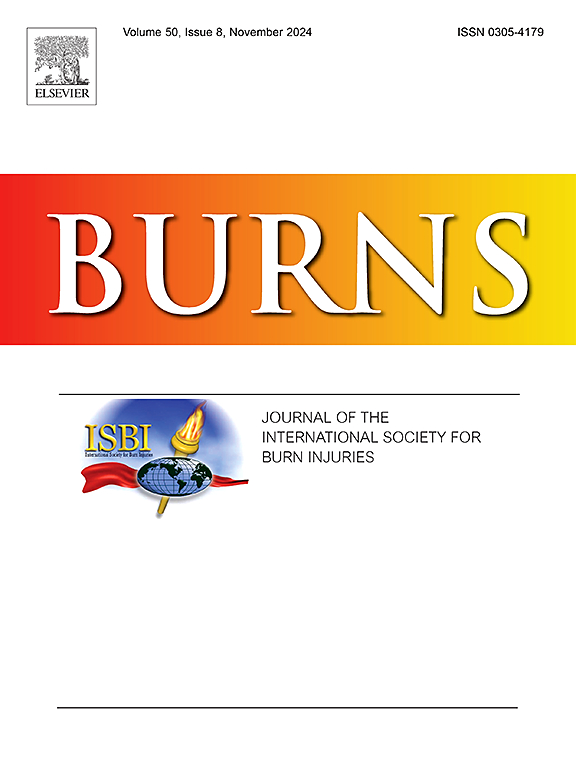Does prolotherapy have an effect on the care of pressure injuries? A pilot study
IF 3.2
3区 医学
Q2 CRITICAL CARE MEDICINE
引用次数: 0
Abstract
Background
This study contributes to wound healing with prolotherapy in people with pressure injuries. The study was planned and conducted as a randomized controlled trial to determine the effect of prolotherapy on the care of pressure injuries.
Methods
The study was carried out with patients with pressure injuries in the intensive care unit of a city hospital between April and June 2023. A power analysis was performed, and the sample size was calculated as 20 patients, including 10 in the intervention and 10 in the control group. The patients in the experimental group were given wound care with gelofusine as prolotherapy in the morning and evening for three days, and the injury site was covered with a sterile sponge and fixation tape. The patients in the control group were treated with saline in the morning and evening for three days. In both groups, the wound width, depth, and length were measured and evaluated prior to each intervention for three days.
Results
In the study, a significant difference was found between the mean ages of the participants in the experimental and control groups (p < 0.05). The decrease in width measurements in the experimental group was found to be statistically significant compared to the previous measurements, while the increase in width measurements in the control group was significant compared to the previous measurements (p < 0.05). Depth measurements decreased statistically significantly in the experimental group, while they increased significantly in the control group compared to previous measurement values (p < 0.05).
Conclusion
In conclusion, it was determined that the administration of gelofusine for pressure injuries as prolotherapy in the experimental group may be more effective in wound healing than saline treatment applied in the control group. Further studies are warranted.
前驱疗法对压伤的护理有效果吗?一项初步研究。
背景:本研究有助于前驱治疗压伤患者的伤口愈合。本研究计划并作为一项随机对照试验进行,以确定前驱治疗对压伤护理的影响。方法:选取2023年4 - 6月在某市医院重症监护病房住院的压力性损伤患者为研究对象。进行功效分析,计算样本量为20例,其中干预组10例,对照组10例。实验组患者于早晚用gelofusine作为前哨治疗创面护理,连续3天,损伤部位用无菌海绵和固定带覆盖。对照组患者每天早晚给予生理盐水治疗,连续3天。在两组中,在每次干预前三天测量和评估伤口的宽度、深度和长度。结果:在本研究中,实验组和对照组受试者的平均年龄有显著差异(p )。结论:结论:实验组给予格洛夫辛作为压伤前治疗的创面愈合可能比对照组给予生理盐水治疗更有效。进一步的研究是必要的。
本文章由计算机程序翻译,如有差异,请以英文原文为准。
求助全文
约1分钟内获得全文
求助全文
来源期刊

Burns
医学-皮肤病学
CiteScore
4.50
自引率
18.50%
发文量
304
审稿时长
72 days
期刊介绍:
Burns aims to foster the exchange of information among all engaged in preventing and treating the effects of burns. The journal focuses on clinical, scientific and social aspects of these injuries and covers the prevention of the injury, the epidemiology of such injuries and all aspects of treatment including development of new techniques and technologies and verification of existing ones. Regular features include clinical and scientific papers, state of the art reviews and descriptions of burn-care in practice.
Topics covered by Burns include: the effects of smoke on man and animals, their tissues and cells; the responses to and treatment of patients and animals with chemical injuries to the skin; the biological and clinical effects of cold injuries; surgical techniques which are, or may be relevant to the treatment of burned patients during the acute or reconstructive phase following injury; well controlled laboratory studies of the effectiveness of anti-microbial agents on infection and new materials on scarring and healing; inflammatory responses to injury, effectiveness of related agents and other compounds used to modify the physiological and cellular responses to the injury; experimental studies of burns and the outcome of burn wound healing; regenerative medicine concerning the skin.
 求助内容:
求助内容: 应助结果提醒方式:
应助结果提醒方式:


